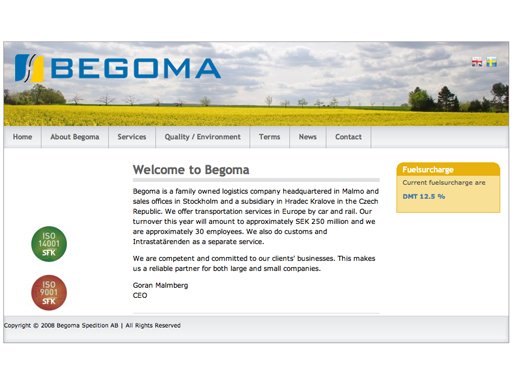Our client – Begoma is a family owned logistics company headquartered in Malmo and sales offices in Stockholm and a subsidiary in Hradec Kralove in the Czech Republic. Begoma offers transportation services in Europe by car and rail. Estimated turnover by the end of 2012 will be SEK 250 million. The company consists of 30 employees. Additional services are customs and Intrastatärenden as a separate service.

Project size: 5 people
Solution: client desktop application
Duration: since March 2011 up till now
Purpose (task)
The goal client turned with to Diatom Enterprises was to re-write a client application that will help to automate some business processes such as adding and handling multiple orders, traffic planning, invoice generation including price calculation. The old system was written in MS-Access back in the late 90s. The increased and changing business demands required the stakeholder to upgrade their system.
The task of Diatom was to design and develop a new system that would be capable to support growing business demands – such as XML data integration, web orders, web reporting as well as traffic management tools. The system was built as a desktop application for office use of the Begoma employees and its subsidiaries. The Web client was also developed to add the capacity for the Begoma’s clients to place the orders online and to track the status of their orders. The system has an algorithmically advanced module for load and traffic management which improves the overall efficiency of the company.
A good product must have a good name, as it were your own child you take care of. The CEO of Begoma Goran Malmberg had a friend and his wife was originally from Riga, hence he decided to use that good coincidence and named the product Irena by the name of a friend’s wife. Our team liked the idea a lot, as Diatom’s head office is located in Riga as well.
Process (implementation, solution)
Diatom Enterprises started the project in March 2011. The first phase consisted of our team working to elicit requirements from Begoma’s team, define a solution architecture, and create a development plan for the project.
As soon as requirements with the client were synced, we agreed to use Agile methodology. This decision was made based on the fact that requirements could be slightly changed in the near future. Right after that developing team stepped into a planning phase. During this time major client application design patterns were reviewed along with proven third-party component frameworks as nobody wanted to reinvent the wheel. Diatom Enterprises wanted to save time on routine and focus on business value.
Diatom’s team made some valuable recommendations during the development process, which gave Begoma confidence that our team can address challenges of the project development process and takes full responsibility for the product delivered, and are not just programmers that are doing what they are told. Later on, our business relationships grew into a true friendship and we wish all vendors had such an amazing client as Begoma.
Development cycle without challenges rising on the way is utopia, an ideal case which happens to be rare. The primary issue was performance. The application was relying on third party component framework. Turned out that it had few memory leaks and the client just wasted resources. There was a huge impact on memory with every new form that was opened. We addressed this issue to the company that provided the component framework. The bug was resolved with the next release. As soon as the new release was delivered, it introduced another issue – few form controls were no longer backward compatible which required additional time to be spent for adjustments and testing. Begoma was informed about the situation right away and understood that Diatom will resolve it no matter what. A few weeks later when the patch was deployed to the application server, it was running way smoother in comparison with the initial version.
Results
The first version of the application was launched in early September 2011 fitting in the deadline. The results were outstanding. End users were giving positive feedback about the new version. They really liked the fact that basic daily routines got automated as much as possible and human errors were minimized.
The result of the two-year development cycle is a successful system which is in daily operation by more than 30 users of the client staff. The implementation of the system reduced the overhead associated with manual scheduling and load management processes while at the same increasing the throughput of the number of business transactions that are being processed on a daily basis.
Diatom’s development team did an amazing job, nonetheless there’s always the great ways to improve, here’s why the contract with the client got extended and we are working on adding more features to Irena application.